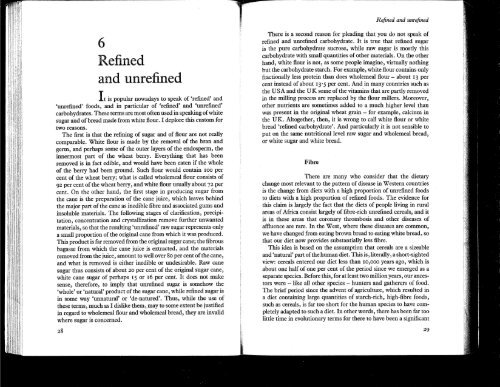John_Yudkin_-_Pure_White_and_Deadly_revised_1986_OCR
John_Yudkin_-_Pure_White_and_Deadly_revised_1986_OCR
John_Yudkin_-_Pure_White_and_Deadly_revised_1986_OCR
You also want an ePaper? Increase the reach of your titles
YUMPU automatically turns print PDFs into web optimized ePapers that Google loves.
Refined <strong>and</strong> unrefined<br />
6<br />
Refined<br />
<strong>and</strong> unrefined<br />
I t is popular nowadays to speak of 'refined' <strong>and</strong><br />
'unrefined' foods, <strong>and</strong> in particular of 'refined' <strong>and</strong> 'unrefined'<br />
carbohydrates. These terms are most often used in speaking of white<br />
sugar <strong>and</strong> of bread made from white flour. I deplore this custom for<br />
two reasons.<br />
The first is that the refining of sugar <strong>and</strong> of flour are not really<br />
comparable. <strong>White</strong> flour is made by the removal of the bran <strong>and</strong><br />
germ, <strong>and</strong> perhaps some of the outer layers of the endosperm, the<br />
innermost part of the wheat berry. Everything that has been<br />
removed is in fact edible, <strong>and</strong> would have been eaten if the whole<br />
of the berry had been ground. Such flour would contain 100 per<br />
cent of the wheat berry; what is called wholemeal flour consists of<br />
92 per cent of the wheat berry, <strong>and</strong> white flour usually about 72 per<br />
cent. On the other h<strong>and</strong>, the first stage in producing sugar from<br />
the cane is the preparation of the cane juice, which leaves behind<br />
the major part of the cane as inedible fibre <strong>and</strong> associated gums <strong>and</strong><br />
insoluble materials. The following stages of clarification, precipitation,<br />
concentration <strong>and</strong> crystallization remove further unwanted<br />
materials, so that the resulting 'unrefined' raw sugar represents only<br />
a small proportion of the original cane from which it was produced.<br />
This product is far removed from the original sugar cane; the fibrous<br />
bagasse from which the cane juice is extracted, <strong>and</strong> the materials<br />
removed from the juice, amount to well over 80 per cent of the cane,<br />
<strong>and</strong> what is removed is either inedible or undesirable. Raw cane<br />
sugar thus consists of about 20 per cent of the original sugar cane,<br />
white cane sugar of perhaps 15 or 16 per cent. It does not make<br />
sense, therefore, to imply that unrefined sugar is somehow the<br />
'whole' or 'natural' product of the sugar cane, while refined sugar is<br />
in some way 'unnatural' or 'de-natured'. Thus, while the use of<br />
these terms, much as I dislike them, may to some extent be justified<br />
in regard to wholemeal flour <strong>and</strong> wholemeal bread, they are invalid<br />
where sugar is concerned.<br />
There is a second reason for pleading that you do not speak of<br />
refined <strong>and</strong> unrefined carbohydrate. It is true that refined sugar<br />
is the pure carbohydrate sucrose, while raw sugar is mostly this<br />
carbohydrate with small quantities of other materials. On the other<br />
h<strong>and</strong>, white flour is not, as some people imagine, virtually nothing<br />
but the carbohydrate starch. For example, white flour contains only<br />
fractionally less protein than does wholemeal flour - about 13 per<br />
cent instead of about 13·5 per cent. And in many countries such as<br />
the U SA <strong>and</strong> the UK some of the vitamins that are partly removed<br />
in the milling process are replaced by the flour millers. Moreover,<br />
other nutrients are sometimes added to a much higher level than<br />
was present in the original wheat grain - for example, calcium in<br />
the UK. Altogether, then, it is wrong to call white flour or white<br />
bread 'refined carbohydrate'. And particularly it is not sensible to<br />
put on the same nutritional level raw sugar <strong>and</strong> wholemeal bread,<br />
or white sugar <strong>and</strong> white bread.<br />
Fibre<br />
There are many who consider that the dietary<br />
change most relevant to the pattern of disease in Western countries<br />
is the change from diets with a high proportion of unrefined foods<br />
to diets with a high proportion of refined foods. The evidence for<br />
this claim is largely the fact that the diets of people living in rural<br />
areas of Africa consist largely of fibre-rich unrefined cereals, <strong>and</strong> it<br />
is in these areas that coronary thrombosis <strong>and</strong> other diseases of<br />
affluence are rare. In the West, where these diseases are common,<br />
we have changed from eating brown bread to eating white bread, so<br />
that our diet now provides substantially less fibre.<br />
This idea is based on the assumption that cereals are a sizeable<br />
<strong>and</strong> 'natural' part of the human diet. This is, literally, a short-sighted<br />
view: cereals entered our diet less than 10,000 years ago, which is<br />
about one half of one per cent of the period since we emerged as a<br />
separate species. Before this, for at least two million years, our ancestors<br />
were - like all other species - hunters <strong>and</strong> gatherers of food.<br />
The brief period since the advent of agriculture, which resulted in<br />
a diet containing large quantities of starch-rich, high-fibre foods,<br />
such as cereals, is far too short for the human species to have completely<br />
adapted to such a diet. In other words, there has been far too<br />
little time in evolutionary terms for there to have been a significant<br />
29



